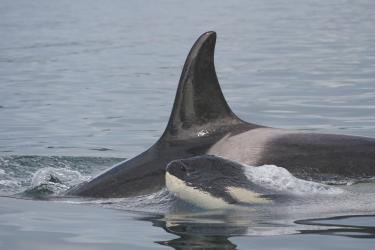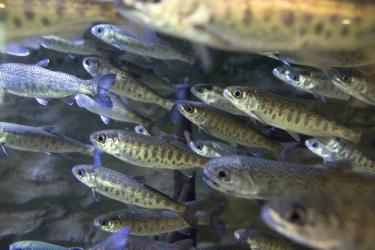Derelict nets “ghostfishing” in the murky depths of Puget Sound might sound like the plot of a horror film, but for marine mammals, seabirds, fish, and invertebrates the threat is all too real.
NWFSC scientist Tom Good and colleagues are collecting and analyzing gillnets as part of a Northwest Straits Commission (NWSC) project to remove derelict fishing gear from Puget Sound and the Northwest Straits. These gillnets, along with pots, traps and other gear can entangle and kill animals, damage marine habitats, and pose navigation hazards long after being lost or abandoned.
Analysis of 870 recovered gillnets, detailed in an paper published in the January 2010 edition of Marine Pollution Bulletin, found evidence of over 32,000 organisms - marine invertebrates (31,278), fish (1036), birds (514), and mammals (23) entangled in the nets. In total, at least 117 species were identified. When recovered from the nets, all mammals and birds, 93% of fish, and 56% of invertebrates were dead. The true mortality figure is likely much higher, as some organisms fall out when the net is removed and completely decomposed organisms leave no remains.
Good and his team targeted areas of known derelict gear accumulation based on years of reported sightings and also found additional unreported gear in the course of surveys. Although newer nets were more likely to entangle a greater number and diversity of species, older nets also contained fresh specimens. Instead of becoming weighted down and more visible as they collected organisms, these nets continued to catch a variety of animals decades after being lost.
Gillnets use varying mesh size, net length, and depth to target specific fish species and reduce bycatch. This does not reduce the capture of target or non-target species by gear lost to the environment, however. The derelict gear recovered in this survey contained many non-target species, including seabirds and mammals attracted to the nets in pursuit of prey. A single net abandoned for only one week off of south San Juan Island contained 25 target sockeye salmon, plus 335 non-target fish, 68 crabs, and a harbor seal.
For the vast majority of nets, the total time spent in the marine environment is unknown, making it difficult to accurately determine how many organisms were killed over time. A “back-of-the-envelope” estimate suggests that the 870 recovered gillnets may have killed as many as 450,000 marine invertebrates, 12,000 fish, 12,000 marine birds, and 400 marine mammals.
According to the Washington Department of Fish and Wildlife, thousands of gillnets have likely been lost in Puget Sound over the past 30 years due to fishing of Pacific salmon, Pacific cod, and spiny dog fish. Since the 1950s, most fishing gear has been made of synthetic materials that, unlike the natural materials used in previous decades, resist degradation.
Worldwide, about 640,000 tons of fishing gear is lost or discarded into oceans each year. In Puget Sound, gillnet loss is down due to reduced commercial fishing and improved navigation and charting technologies. This should minimize future gear loss and speed up recovery.
Of larger concern is the decades’ worth of derelict gear still in Puget Sound. Unless found and removed, this gear will continue to degrade valuable marine resources and needlessly kill threatened and endangered species, including Chinook and sockeye salmon, and black and quillback rockfish. In 2009, the Northwest Strait Foundation was awarded a $4.6 million grant from NOAA to remove an additional 3,000 high priority derelict nets by 2012, and Tom Good will continue his collaborative work to estimate the biological impacts of derelict gear on the Puget Sound ecosystem.



